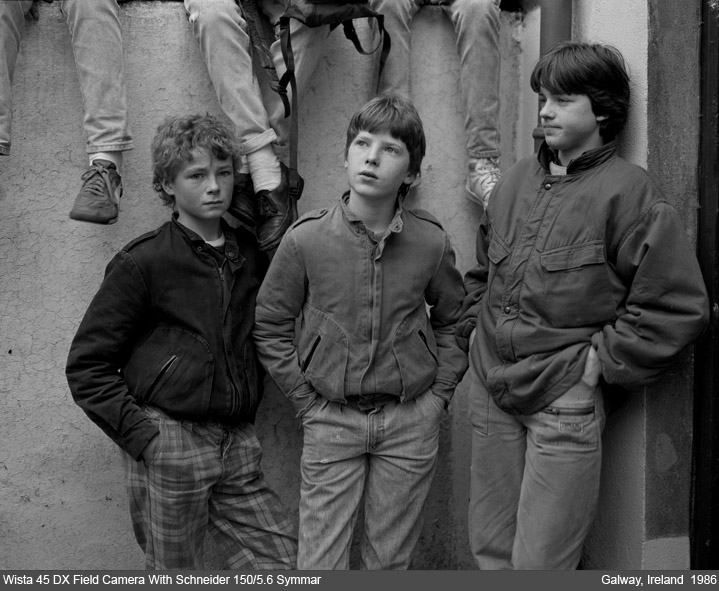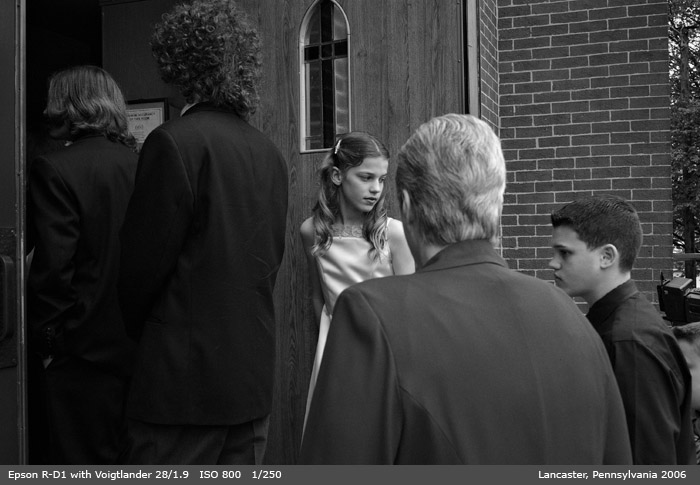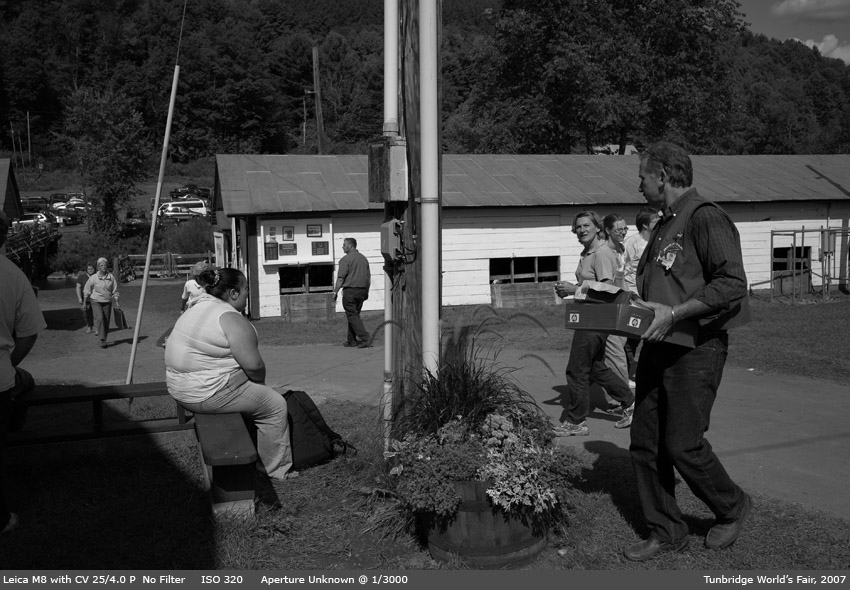Yes, It Matters I
originally wrote this essay for "Luminous Landscape" in
response to an essay Michael Reichman had written called
"Your
Camera Does Matter".
Classical pianists tend to care about which pianos they play. I know this, in part, because I was once married to a classical composer who cared not only about the sounds a piano made but also about its action - about the ways in which her hands and feet connected with the strings of the instrument. The painter Vincent Van Gogh cared very much about the materials he was using to make his pictures. His letters to his brother Theo, an art dealer who supported Van Gogh throughout much of his adult life, often included requests for money to pay for very specific art materials from specific makers. The writer Jack Kerouac preferred to use a specific kind of typewriter which he felt was important to the way he worked. My friend Ben Lifson, an art critic and essayist, has always had specific preferences for the sort of computer keyboards he writes with. I myself have written professionally for several years now and went through three types of keyboards for my Macintosh before finding one that had the kind of action I wanted for my own writing. Many guitarists worth their salt have specific preferences for the kinds of guitars they like to play. The woman who cut my hair last week told me that she spent over $200 for a specific kind of professional scissors that not only cut very well but which also should help to prevent carpal tunnel syndrome in her cutting arm. Experienced professional automobile and motorcycle mechanics usually have specific preferences in the types and makes of tools they use. And, to experienced carpenters, not all hammers are alike. Now, to be sure, owning a fine piano will not make one into Mitsuko Uchida. Owning the best paints, brushes and canvasses will not make one into Jan Vermeer. Buying the latest and fastest sport motorcycle will not make one into Miguel Duhamel. Owning a fine pen, typewriter or keyboard will not make one into Marcel Proust. Buying a rare and coveted guitar will not make one into Eric Clapton. And, of course, buying a Leica M will not make one into Robert Frank any more than buying a good view camera will turn one into Paul Strand. I think that many of us of might agree that our tools, in and of themselves, will not make the work we do great or mediocre, competent or laughable. Of course, great work in any field is done, first and foremost, with the mind and the body. Yet, it is a mistake to extrapolate from this fact that one's tools do not matter. They do matter and they always have, across many fields, artistic and otherwise. They matter because tools mediate the connection between our intentions and our materials (for photographers - our subject). The waters surrounding these sort of discussions in photography have been muddy for a long time, in part because of relentless advertising by camera makers. For decades now, camera and lens companies have spent billions of dollars to entice our spending through a combination of flattery and illusion. "Release the power of your creative vision with Canon cameras and lenses..." -- that sort of thing. And I chose Canon at random for that sentence; virtually every major camera company has been guilty of this kind of manipulation in their advertising. The message is clear - we're all capable of creating photographic masterpieces if only we buy the right equipment to unlock our magic hidden potential. Seen for what they really are, these sorts of advertisements are preposterous. But, by dint of time and widespread exposure, the arrows of these myths have found their marks in the minds, and wallets, of many photographers. Consciously or otherwise, the message has been absorbed by photographers all over the world: "buy the right camera and lenses and you'll make wonderful pictures". I suspect that myths like this are what have lead many to claim that one's choice of camera or lenses is not important. And, to the extent that such comments are designed to shift our attention away from equipment towards photography itself, I can certainly sympathize with the intention. Yet such a statement is simply incorrect. In photography, as in many fields of work, our choice of tools can be important to the work we produce. In support of the "one's camera doesn't matter" theory people sometimes argue that photographer "X" would have made great work whether he was using a Deardorf or a Holga. But to advance such a theory is to misunderstand why one talented photographer, intentionally, chooses the Deardorf and another talented photographer, intentionally, the Holga. Could a given photographer make his or her best work with any camera handed to him or her? Maybe, but probably not. The evidence presented to us by the history of photography, especially as it relates to the cameras various photographers have chosen to use for their specific work, largely supports the latter answer.  Many may realize, for example, that the 8" x 10" view camera is often used because of its potential for precise rendering as well as its flexibility with lens movements. Some may realize that the kind of slow and deliberate pace such a camera encourages can also be essential to certain photographers for certain work, or that seeing the subject on a large ground glass can be an important part of the creative process. Yet, some who like to trot out the Holga camera as a star example in these kinds debates may not realize that the whole toy camera movement, in the photographic art world, began specifically *because* of the way these cameras draw. Photographers who made waves with the Holga have used the camera, and its way of drawing, its light leaks, its plastic lens, very intentionally and for specific visual purposes. They've made pictures with the Holga that *look like* pictures made with a Holga. Photographers who don't realize this have, perhaps, never seen these Holga prints on exhibition.  The great Hungarian photographer Andre Kertesz wrote, about his own photography: "I see the thing. I feel the thing. I make the thing." The thing we see is the subject and the mediator is the viewfinder. The specific kind of and quality of viewfinder one uses can be very important to his or her work. I myself am partial to the rangefinder camera because it allows me to see the whole subject (near elements and far) in focus and because the camera's frame lines allow me to see what will and will not fall within the edges of my pictures. Other photographers will prefer other finders for other reasons. The thing we feel is the camera body itself, its shape, heft, exposure controls, shutter release, etc. Working with a camera that feels intuitive, responsive, natural, etc. can be extremely important to one's process of making pictures. We don't all prefer the same qualities in a camera but many of us will do our best work when using a camera that works with, rather than against, us. Finally, the thing we make is the picture. The ways in which our lenses, film or sensor/electronics/etc. work together play an important role in how this picture looks. The photographer controls the process but the lens and camera make the actual "drawing" itself. Matching that drawing to the way we want a picture to look can be important.  Walker Evans, for example, used a wide range of cameras in his work, including large view cameras, folding medium format cameras, 35 mm rangefinders and, late in his career, the little Polaroid SX-70. But if one reads his writing about his own work (or James Agee's comments about the same), it becomes quite clear that Evans chose different cameras for different purposes. A friend of mine used to ride the subways with Evans while he was photographing passengers using a small Leica. Other of his best known pictures were made with view cameras. When photographing tenant farmers for the pictures that were eventually published in "Let Us Now Praise Famous Men", Evans frequently changed from one camera to another, during the course of each day, depending on what his needs were. The work that earned Garry Winogrand's place as one of the master photographers of the Twentieth Century was all done with 35 mm rangefinder cameras and certain lenses that he favored (and recommended to other photographers). Yet, near the end of his career, he told certain friends that he wanted to try making nudes with an 8" x 10" view camera. That choice of camera was no accident. To anyone who is familiar with the history of photography, these sorts of examples can be found again and again. Most of the photographers who've made an impact using this medium have eventually found their way to the cameras and lenses that best suit them. I don't know of any evidence that suggests that any major photographer, in the history of the medium so far, has been indifferent to the cameras and lenses he or she has chosen to make his or her work. Diane Arbus liked 2 1/4 square cameras and used them better than any other photographer I know of. Most of the work that defined Paul Strand's career (very early pictures excepted) was done with view cameras. A notable number of master photographers have done most or all of their work with Leica rangefinders, including several who are using these cameras now as I write this.  It's true that the tail shouldn't wag the dog. It's true that photographers and pictures are more important than cameras and lenses. It's true that hours spent studying photographs and paintings themselves will often be far more valuable to a photographer than hours spent worrying over what equipment to buy next. It's true that many have been conned by decades of advertising into believing that becoming a good photographer is mostly a matter of buying the "best" cameras and lenses. It's true that there is no such thing as a "best" camera or a "best" lens for all photographers. It's true that we generally do not need the newest and most expensive cameras and lenses to make strong pictures. That's all true. But it's not true that cameras and lenses do not matter. There is no best camera and no best lens, globally, but there may well be a combination of camera and lens that best suits a specific photographer for a specific set of work. It might be a combination that costs forty dollars or forty-thousand but whatever it is, it can play an important role in the creation and look of a given photographers' work. This article was first published February 13, 2011 on Luminous Landscape. Many of Sean Reid's reviews, essays and other articles can be found in the subscriber section of Reid Reviews. They include an extensive review of the Leica SL and tests of various rangefinder and Leica R lenses on both the SL and the Leica M-240. Reid Reviews accepts no advertising and is paid for entirely by subscribers. Written primarily for professional and serious amateur photographers the site has become known for its in-depth analysis based on both field and studio testing. |
